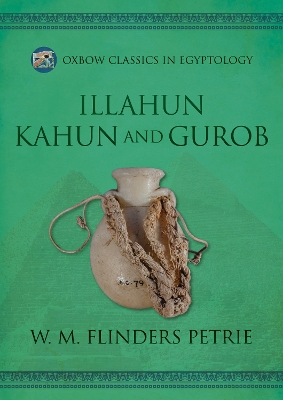Flinders Petrie undertook excavation and survey of ancient Egyptian towns in the Faiyum oasis, south-west of Cairo, in 1888–90. The work included opening of a pyramid at Illahun and excavation of a nearby cemetery, excavation and planning of over 2000 chambers of the city of Kahun, excavation of a Ptolemaic cemetery at Gurob, and work at the temple site at Medinet Gurob. This facsimile volume presents brief descriptions of the work with a focus on the artifacts and inscriptions recovered and recorded with an attempt to establish a chronology of occupation in the oasis.
The entrance to the pyramid at Illahun, its peculiar structure and exploration of its various internal passages and chambers are described, including the sepulchre containing the red granite sarcophagus of Usertesen II, accompanied by a table of offerings. A series of nearby tombs produced a wealth of artifacts associated with burials, wooden coffins and cartonnages, including glazed objects, amulets, scarabs, beads, silver cowries, carved and inscribed wooden objects and statuettes. At Kahun the complete surviving plan of the ancient town revealed a regular layout thought by Petrie to be the work of a single architect. He identified the acropolis, at least eight great houses, dwelling houses, rubbish heaps, and storerooms arranged along numerous narrow ‘workmen’s’ streets with drainage channels. Much evidence for construction materials and techniques and house fittings, wall plaster and paint was recovered. Portable objects included decorated pottery, some of it imported; pottery trays of offerings; stonework; wooden carvings; flint sickles and knives; inscribed stelae; a variety of copper tools; scarabs and clay seals; stone weights and many tools, including several workshop groups. A family tomb in the cellar beneath one house contained 12 coffins, each containing several bodies with grave offerings buried in succession, two baby boxes and a heap of offerings. At Gurob, the plan of the main temple and surrounding enclosures, within which were contained most of the houses, was established and an outline of its history determined. An unusual practice of burning personal belongings in pits beneath the houses was identified and the groups of objects and inscriptions discussed. The nearby cemetery was also investigated with pit-like tombs producing undecorated coffins but finely painted cartonnages, badly decomposed papyri and a few funerary objects. A discussion of the wider urban landscape concludes the narrative. There are specialist reports on the papyri and stone implements.
This series comprises facsimile re-issues of typological catalogues produced between 1898 and 1937 by W.M. Flinders Petrie, and re-issued in facsimile by publishers Aris & Phillips in the 1970s alongside newly-commissioned titles by contemporary experts. Petrie’s catalogues remain invaluable source material today. The Oxbow Classics in Egyptology series now makes a selection of these important resources available again in print for a new generation of students and scholars.
- ISBN10 8888570225
- ISBN13 9798888570227
- Publish Date 15 June 2023
- Publish Status Active
- Publish Country GB
- Imprint Oxbow Books
- Format Paperback
- Pages 98
- Language English
